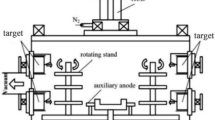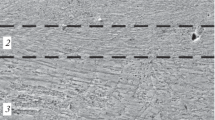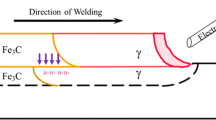The mechanical properties possessed by surface layers of metal alloys hardened by severe plastic deformation methods were studied by indentation. The test materials were AISI O2 and AISI 316L steels and D16 aluminum alloy. Most scientific papers evaluate the mechanical properties of hardened surface layers and thin coatings only by hardness measurement. Hardness alone cannot characterize the ductility of a material without using modern concepts for determining the physical ductility from hardness. The mechanical behavior of a material can only be characterized by determining both the ductility and the yield stress. These quantities can be found by micro- or nanoindentation. We developed indentation methods to find the physical ductility δH and yield stress σSH of the surface layers of metal alloys hardened by various techniques (with analysis of changes in these characteristics across the hardened layer) to select the optimal hardening method. The hardening characterized by the ratio between the yield stresses of the hardened layer and the starting material \( \left({\upsigma}_{{\mathrm{SH}}_{\mathrm{hard}}}/{\upsigma}_{{\mathrm{SH}}_{\mathrm{start}}}\right) \) was much greater for all studied alloys than the hardening characterized by the hardness ratio (HVhard/HVstart). Thus, the use of δH and σSH obtained from standard microhardness measurements enhanced the informative nature and efficiency of the indentation method in studying the mechanical behavior of metal alloy layers hardened by various techniques.


Similar content being viewed by others
References
Yu.V. Milman, S.I. Chugunova, and I.V. Goncharov, “Yield stress and ductility of materials determined by indentation,” in: V.V. Rubanik, Relevant Issues of Strength [in Russian], Vitebsk, Belarus (2018), Chapter 4, pp. 68–87.
Yu.V. Milman, B.A. Galanov, and S.I. Chugunova, “Plasticity characteristic obtained through hardness measurement (overview 107),” Acta Met. Mater., 41, No. 9, 2523–2531 (1993).
B.A. Galanov, Yu.V. Milman, S.I. Chugunova, I.V. Goncharova, and I.V. Voskoboinik, “Application of the improved inclusion core model of the indentation process for the determination of mechanical properties of materials,” Crystals, 87, No. 3, 1–13 (2017), https://doi.org/10.3390/cryst7030087.
Y.V. Milman, B.N. Mordyuk, K.E. Grinkevych, S.I. Chugunova, I.V. Goncharova, A.I. Lukyanov, and D.A. Lesyk, “New possibilities for characterization of wear rate of materials at friction by indentation,” Prog. Phys. Met., 21, 562–589 (2020), https://doi.org/10.15407/ufm.21.04.562.
G.I. Prokopenko, A.L. Berezina, S.M. Voloshko, I.E. Kotenko, and A.P. Burmak, “Surface densification of D16 alloy in ultrasound shock processing,” Metallofiz. Noveish. Technol., 32, No. 3, 397–403 (2010).
M.O. Vasiliev, V. S. Filatova, L. F. Yatsenko, and D. V. Kozyrev, “Microhardness of the VT6 alloy after ultrasound shock processing in different environments,” Metallofiz. Noveish. Tekhnol., 34, No. 6, 821–831 (2012).
A. Al-Janabi, M.R. Malayeri, and O.O. Bardan, “Performance of shot peened surfaces subject to crystallization fouling,” J. Therm. Sci., 111, 379–389 (2017).
S.I. Sidorenko, M.A. Vasiliev, and S.M. Voloshko, “Surface engineering: methods for metal surface hardening by severe plastic deformation,” in: L.M. Lobanov, I.V. Krivstun, and Yu.S. Borisov, Materials Science: Advances and Prospects: in 2 Vols., Vol. 1, Structural and Functional Materials [in Ukrainian], Akademperiodika, Kyiv (2018), pp. 393–413.
D.A. Lesyk, S. Martinez, B.N. Mordyuk, V.V. Dzhemelinskyi, A. Lamikiz, and G.I. Prokopenko, “Effects of laser heat treatment combined with ultrasonic impact treatment on the surface topography and hardness of carbon steel AISI 1045,” Opt. Laser Technol., 111, 424–438 (2019), https://doi.org/10.1016/j.optlastec.2018.09.030.
D. Lesyk, S. Martinez, B. Mordyuk, V. Dzhemelinskyi, and O. Danyleiko, “Effects of the combined laser-ultrasonic surface hardening induced microstructure and phase state on mechanical properties of AISI D2 tool steel,” in: V. Ivanov, J. Trojanowska, J. Machado, O. Liaposhchenko, J. Zajac, I. Pavlenko, M. Edl, and D. Perakovic, Advances in Design, Simulation and Manufacturing II, DSMIE 2019, LNME, Springer, Cham (2020), pp. 188–198, https://doi.org/10.1007/978-3-030-22365-6_19.
Yu.V. Milman, S.I. Chugunova, I.V. Goncharova, and A.A. Golubenko, “Plasticity of materials determined by the indentation method,” Prog. Phys. Met., 19, No. 3, 271–306 (2018), https://doi.org/10.15407/ufm.19.03.271.
A.V. Byakova, Yu.V. Milman, and A.A. Vlasov, “Application of the plasticity characteristic determined by the indentation technique for evaluation of mechanical properties of coatings: I. Specific features of the test method procedure,” Sci. Sintering, 36, 27–41 (2004).
A.I. Yurkova, Yu.V. Milman, and A.V. Byakova, “Structure and mechanical properties of iron subjected to surface severe plastic deformation by attrition: II. Mechanical properties of nano- and submicrocrystalline iron,” Russ. Metall., No. 4, 258–263 (2010).
W.Y. Yeung, S.N. Dub, R. Wuhrer, and Yu.V. Milman, “A nanoindentation study of magnetron co-sputtered nanocrystalline ternary nitride coatings,” Sci. Sintering, 38, 211–221 (2006).
D. Tabor, The Hardness of Metals, Clarendon Press, Oxford (1951), p. 130.
K.L. Johnson, Contact Mechanics, Cambridge University Press (1985).
J.W. Murray, N. Ahmed, T. Yuzawa, T. Nakagawa, S. Sarugaku, D. Saito, and A.T. Clare, “Dry-sliding wear and hardness of thick electrical discharge coatings and laser clads,” Tribol. Int., 150, 106392 (2020), https://doi.org/10.1016/j.triboint.2020.106392.
A.F. Shchurov, A.V. Kruglov, and V.A. Perevoshchikov, “Band structure and low-temperature plasticity of covalent crystals,” Inorg. Mater., 37, No. 4, 349–353 (2001), https://doi.org/10.1023/A:1017571609977.
X. Zhang, B.D. Beake, and S. Zhang, Thin Films and Coatings. Toughening and Toughness Characterization, S. Zhang (ed.), Boca Raton: Taylor & Francis Group. CRC Press, (2015), Chapter 2, p. 48, https://doi.org/10.1201/b18729.
Author information
Authors and Affiliations
Corresponding author
Additional information
Translated from Poroshkova Metallurgiya, Vol. 60, Nos. 5–6 (539), pp. 92–99, 2021.
Rights and permissions
About this article
Cite this article
Chugunova, S., Milman, Y., Lukyanov, A. et al. Study of the Yield Stress and Ductility of Hardened Surface Layers of Metal Alloys by Indentation. Powder Metall Met Ceram 60, 331–336 (2021). https://doi.org/10.1007/s11106-021-00244-y
Received:
Published:
Issue Date:
DOI: https://doi.org/10.1007/s11106-021-00244-y




